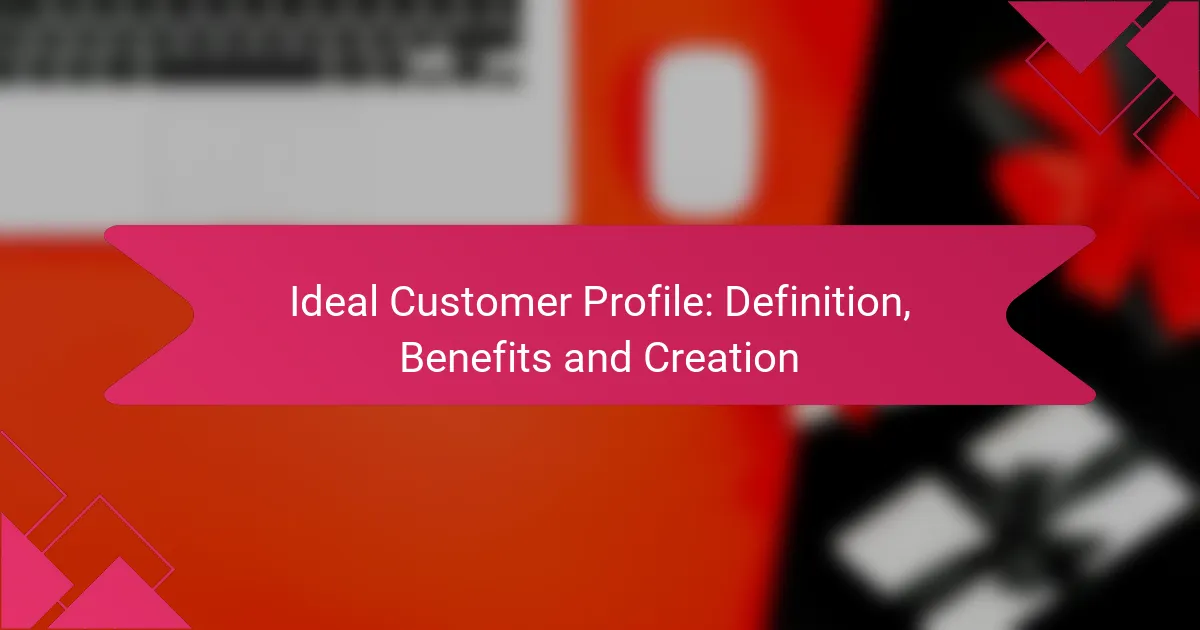An ideal customer profile (ICP) is a detailed description of the customers who would gain the most value from your product or service. By identifying the characteristics, behaviors, and needs of these customers, businesses can tailor their marketing and sales strategies to attract similar individuals. This targeted approach not only enhances customer satisfaction but also drives growth by optimizing resource allocation.

How to create an ideal customer profile?
Creating an ideal customer profile involves identifying the characteristics of your best customers to guide marketing and sales strategies. This profile helps businesses target their efforts more effectively, ensuring resources are allocated to attract similar customers.
Identify key demographics
Start by gathering demographic information such as age, gender, income level, education, and location. This data can often be sourced from customer databases, surveys, or analytics tools. Understanding these demographics allows you to tailor your messaging and product offerings to meet the needs of your target audience.
For example, if your ideal customers are primarily young professionals in urban areas, your marketing strategies should reflect their lifestyle and preferences.
Analyze customer behavior
Examine how your customers interact with your products or services. Look at purchase patterns, frequency of purchases, and engagement with your brand across various channels. Tools like Google Analytics or CRM software can provide insights into customer behavior.
Identifying trends in behavior helps you understand what drives customer loyalty and can inform your marketing strategies to enhance customer retention.
Utilize customer feedback
Collecting and analyzing customer feedback is crucial for refining your ideal customer profile. Use surveys, reviews, and direct feedback to understand what customers value most about your offerings. This information can highlight strengths and areas for improvement.
Regularly engaging with customers through feedback channels ensures that your profile remains relevant and reflects changing preferences or needs.
Segment your market
Market segmentation involves dividing your broader audience into smaller groups based on shared characteristics or behaviors. This allows for more targeted marketing strategies that resonate with specific segments.
For instance, you might segment your market by geographic location, creating tailored campaigns for different regions, which can be particularly effective in diverse markets like the European Union or the United States.
Define customer pain points
Identifying the challenges or pain points your ideal customers face is essential for creating effective solutions. Conduct interviews or surveys to gather insights into their struggles and frustrations related to your industry.
By understanding these pain points, you can position your products or services as solutions, making your marketing efforts more compelling and relevant to your target audience.

What are the benefits of an ideal customer profile?
An ideal customer profile (ICP) helps businesses identify and understand their best customers, leading to several key advantages. By defining an ICP, companies can enhance their marketing and sales efforts, ultimately driving growth and improving customer satisfaction.
Improved targeting strategies
Defining an ideal customer profile allows businesses to focus their marketing efforts on the most promising segments. This targeted approach ensures that resources are allocated efficiently, maximizing the chances of converting leads into customers.
For example, a software company might identify tech startups as their ideal customers, allowing them to tailor their messaging and outreach specifically to this group. By honing in on specific demographics, interests, and behaviors, companies can create more personalized campaigns that resonate with their audience.
Enhanced marketing effectiveness
With a clear ideal customer profile, marketing teams can craft messages that speak directly to the needs and pain points of their target audience. This alignment increases engagement and response rates, making campaigns more effective.
For instance, a clothing retailer might use their ICP to develop targeted social media ads that showcase products appealing to their ideal customers. This strategy not only boosts conversion rates but also enhances brand loyalty as customers feel understood and valued.
Increased customer retention
Understanding the characteristics of ideal customers helps businesses tailor their services and products to meet ongoing needs, leading to higher customer retention rates. Satisfied customers are more likely to remain loyal and make repeat purchases.
For example, a subscription box service can use their ICP to refine their offerings based on customer preferences, ensuring that each box delivers value. This personalized approach fosters long-term relationships and encourages customers to advocate for the brand.
Streamlined sales processes
An ideal customer profile simplifies the sales process by providing sales teams with a clear understanding of who to target and how to approach them. This clarity reduces the time spent on unqualified leads and increases overall efficiency.
Sales representatives can leverage the ICP to prioritize leads that fit the profile, allowing them to focus their efforts on prospects with the highest likelihood of conversion. This targeted strategy can lead to shorter sales cycles and improved sales performance.

What is the definition of an ideal customer profile?
An ideal customer profile (ICP) is a detailed description of the type of customer that would benefit most from your product or service. It outlines the characteristics, behaviors, and needs of these customers, helping businesses focus their marketing and sales efforts effectively.
Detailed customer archetype
A detailed customer archetype includes demographic information such as age, gender, income level, and geographic location. Additionally, it captures psychographic factors like interests, values, and buying motivations. For instance, a tech startup might identify its ideal customer as a 25-35-year-old urban professional with a strong interest in innovation and sustainability.
Creating this archetype involves gathering data from existing customers, market research, and analyzing customer feedback. This process helps in identifying patterns that define the ideal customer, ensuring that marketing strategies are tailored to attract similar profiles.
Focus on high-value customers
Focusing on high-value customers means identifying those who not only purchase frequently but also contribute significantly to revenue. These customers typically have a higher lifetime value and are more likely to refer others. For example, a subscription service might prioritize retaining customers who renew annually over those who opt for monthly plans.
To effectively target high-value customers, businesses should analyze purchasing behaviors and segment their customer base accordingly. This can involve creating targeted marketing campaigns that resonate with the specific needs and preferences of these valuable segments, ultimately leading to increased sales and customer loyalty.

How does an ideal customer profile impact lead generation?
An ideal customer profile (ICP) significantly enhances lead generation by identifying the characteristics of your best customers. This focused approach allows businesses to target their marketing efforts more effectively, ensuring that resources are spent on leads with the highest potential for conversion.
Increases lead quality
By defining an ideal customer profile, businesses can attract higher-quality leads that closely match their best existing customers. This means that the leads generated are more likely to engage with your product or service, resulting in higher conversion rates.
For example, if a software company identifies that its best customers are small businesses in the tech sector, it can tailor its marketing strategies to reach similar organizations. This targeted approach leads to more meaningful interactions and a better return on investment.
Reduces acquisition costs
Creating an ideal customer profile can lead to reduced customer acquisition costs by focusing marketing efforts on the most promising segments. When businesses know who their ideal customers are, they can allocate their budgets more efficiently, minimizing wasted spending on less relevant leads.
For instance, a company that spends resources on broad advertising may find that targeting specific demographics or industries lowers their cost per acquisition by a significant margin, potentially by 20-30%. This strategic targeting not only saves money but also enhances overall marketing effectiveness.

What tools can help in creating an ideal customer profile?
Several tools can assist in creating an ideal customer profile (ICP) by analyzing customer data and behavior. These tools help businesses identify key characteristics of their best customers, enabling more targeted marketing and sales strategies.
HubSpot CRM
HubSpot CRM offers a user-friendly platform that allows businesses to track customer interactions and gather data on leads. By utilizing its reporting features, companies can analyze customer demographics, behaviors, and preferences to build a detailed ICP.
Additionally, HubSpot’s integration with marketing tools enables users to segment their audience based on the ideal customer attributes. This segmentation helps in crafting personalized marketing campaigns that resonate with target customers.
Salesforce
Salesforce provides robust analytics and customer management capabilities, making it a powerful tool for creating an ideal customer profile. Its customizable dashboards allow businesses to visualize customer data and identify trends that define their best customers.
With features like lead scoring and customer journey mapping, Salesforce helps organizations prioritize leads that fit their ICP. This targeted approach can significantly enhance conversion rates and improve overall sales efficiency.
Google Analytics
Google Analytics is essential for understanding website visitor behavior, which is crucial for developing an ideal customer profile. By analyzing metrics such as user demographics, interests, and engagement patterns, businesses can gain insights into who their ideal customers are.
Utilizing Google Analytics’ audience segmentation tools allows companies to create targeted marketing strategies based on real user data. This data-driven approach helps in refining the ICP over time, ensuring it remains relevant as market conditions change.

What are common mistakes in developing an ideal customer profile?
Common mistakes in developing an ideal customer profile include neglecting data analysis and overgeneralizing customer traits. These errors can lead to ineffective marketing strategies and wasted resources.
Neglecting data analysis
Failing to analyze data can result in an incomplete understanding of your target audience. Relying solely on assumptions or anecdotal evidence may lead to profiles that do not accurately represent your ideal customers.
To avoid this mistake, utilize available data sources such as customer surveys, sales records, and website analytics. Look for patterns in demographics, purchasing behavior, and engagement metrics to create a more accurate profile.
Overgeneralizing customer traits
Overgeneralizing customer traits can dilute the effectiveness of your ideal customer profile. Assuming that all customers share the same characteristics can overlook important nuances that differentiate segments within your audience.
Instead, focus on identifying specific traits that are relevant to your product or service. Consider factors like age, location, interests, and pain points, and create sub-profiles for different customer segments to enhance targeting efforts.









